Biodegradation Studies of Biobased Mulch Films Reinforced with Cellulose from Waste Mango
Abstract
:1. Introduction
2. Material and Methods
2.1. Preparation of Liquid Mulch Film
2.2. Film Thickness
2.3. Soil Composition
2.4. Biodegradation Studies in Soil
2.5. Surface Analysis of Mulches
2.6. Functional Group Analysis
3. Results
3.1. Biodegradation Studies in Soil
3.2. Surface Analysis of Mulches
3.3. Functional Group Analysis
4. Conclusions
Author Contributions
Funding
Data Availability Statement
Acknowledgments
Conflicts of Interest
References
- Haapala, T.; Palonen, P.; Tamminen, A.; Ahokas, J. Effects of different paper mulches on soil temperature and yield of cucumber (Cucumis sativus L.) in the temperate zone. Agric. Food Sci. 2015, 24, 52–58. [Google Scholar] [CrossRef]
- Tofanelli, M.B.D.; Wortman, S.E. Benchmarking the agronomic performance of biodegradable mulches against polyethylene mulch film: A meta-analysis. Agronomy 2020, 10, 1618. [Google Scholar] [CrossRef]
- Gao, X.; Fu, C.; Li, M.; Qi, X.; Jia, X. Effects of Biodegradation of Corn-Starch–Sodium-Alginate-Based Liquid Mulch Film on Soil Microbial Functions. Int. J. Environ. Res. Public Health 2022, 19, 8631. [Google Scholar] [CrossRef] [PubMed]
- Yu, Y.Y.; Turner, N.C.; Gong, Y.H.; Li, F.M.; Fang, C.; Ge, L.J.; Ye, J.S. Benefits and limitations to straw- and plastic-film mulch on maize yield and water use efficiency, a meta-analysis across hydrothermal gradients. Eur. J. Agron. 2018, 99, 138–147. [Google Scholar] [CrossRef]
- Kader, M.A.; Singha, A.; Begum, M.A.; Jewel, A.; Khan, F.H.; Khan, N.I. Mulching as water-saving technique in dry land agriculture. Bull. Natl. Res. Cent. 2019, 43, 147. [Google Scholar] [CrossRef]
- Samphire, M.; Chadwick, D.R.; Jones, D.L. Biodegradable plastic mulch films increase yield and promote nitrogen use efficiency in organic horticulture. Front. Agron. 2023, 5, 1141608. [Google Scholar] [CrossRef]
- Chen, Y.; Leng, Y.; Liu, X.; Wang, J. Microplastic pollution in vegetable farmlands of suburb Wuhan, Central China. Environ. Pollut. 2020, 257, 113449. [Google Scholar] [CrossRef]
- He, G.; Wang, Z.; Li, S.; Malhi, S.S. Plastic mulch: Tradeoffs between productivity and greenhouse gas emissions. J. Clean. Prod. 2018, 172, 1311–1318. [Google Scholar] [CrossRef]
- Kasirajan, S.; Ngouajio, M. Polyethylene and biodegradable mulches for agricultural applications: A review. Agron. Sustain. Dev. 2012, 32, 501–529. [Google Scholar] [CrossRef]
- Chamas, A.; Moon, H.; Zheng, J.; Qiu, Y.; Tabassum, T.; Jang, J.H.; Abu-Omar, M.; Scott, S.L.; Suh, S. Degradation rates of plastics in the environment. ACS Sustain. Chem. Eng. 2020, 8, 3494–3511. [Google Scholar] [CrossRef]
- Briassoulis, D.; Babou, E.; Hiskakis, M.; Kyrikou, I. Analysis of long-term degradation behaviour of polyethylene mulching films with pro-oxidants under real cultivation and soil burial conditions. Environ. Sci. Pollut. Res. Int. 2015, 22, 2584–2598. [Google Scholar] [CrossRef] [PubMed]
- Peng, X.; Dong, K.; Wu, Z.; Wang, J.; Wang, Z.L. A review on emerging biodegradable polymers for environmentally benign transient electronic skins. J. Mater. Sci. 2021, 56, 16765–16789. [Google Scholar] [CrossRef]
- Kopitar, D.; Marasovic, P.; Jugov, N.; Schwarz, I. Biodegradable Nonwoven Agrotextile and Films—A Review. Polymers 2022, 14, 2272. [Google Scholar] [CrossRef]
- Cerqueira, J.C.; Penha, J.D.S.; Oliveira, R.S.; Guarieiro, L.L.N.; Melo, P.D.S.; Viana, J.D.; Machado, B.A.S. Production of biodegradable starch nanocomposites using cellulose nanocrystals extracted from coconut fibers. Polimeros 2017, 27, 320–329. [Google Scholar] [CrossRef]
- Khenblouche, A.; Bechki, D.; Gouamid, M.; Charradi, K.; Segni, L.; Hadjadj, M.; Boughali, S. Extraction and characterization of cellulose microfibers from Retama raetam stems. Polimeros 2019, 29, e2019011. [Google Scholar] [CrossRef]
- Amiri, H.; Aghbashlo, M.; Sharma, M.; Gaffeys, J.; Manning, L.; Moosavi, S.M.; Kennedy, J.F.; Gupta, V.K.; Tabatabaei, M. Chitin and chitosan derived from crustacean waste valorization streams can support food systems and the UN Sustainable Development Goals. Nat. Food 2022, 3, 822–828. [Google Scholar] [CrossRef]
- Mohan, K.; Ravichandran, S.; Muralisankar, T.; Uthayakumar, V.; Chandirasekar, R.; Rajeevgandhi, C.; Karthick Rajan, D.; Seedevi, P. Extraction and characterization of chitin from sea snail Conus inscriptus (Reeve, 1843). Int. J. Biol. Macromol. 2019, 126, 555–560. [Google Scholar] [CrossRef]
- Hu, L.; Zhao, P.; Wei, Y.; Guo, X.; Deng, X.; Zhang, J. Properties of allicin–zein composite nanoparticle gelatin film and their effects on the quality of cold, fresh beef during storage. Foods 2023, 12, 3713. [Google Scholar] [CrossRef] [PubMed]
- Liu, M.; Shen, R.; Wang, L.; Yang, X.; Zhang, L.; Ma, X.; He, L.; Li, A.; Kong, X.; Shi, H. Preparation, optimization, and characterization of bovine bone gelatin/sodium carboxymethyl cellulose nanoemulsion containing thymol. Foods 2024, 13, 1506. [Google Scholar] [CrossRef]
- Sander, M. Biodegradation of polymeric mulch films in agricultural soils: Concepts, knowledge gaps, and future research directions. Environ. Sci. Technol. 2019, 53, 2304–2315. [Google Scholar] [CrossRef]
- Lorenzo-Santiago, M.A.; Rendón-Villalobos, R. Isolation and characterization of micro cellulose obtained from waste mango. Polimeros 2020, 30, e2020036. [Google Scholar] [CrossRef]
- Li, Q.; Zhou, J.; Zhang, L. Structure and properties of the nanocomposite films of chitosan reinforced with cellulose whiskers. J. Polym. Sci. Polym. Phys. 2009, 47, 1069–1077. [Google Scholar] [CrossRef]
- Pranoto, Y.; Lee, C.M.; Park, H.J. Characterizations of fish gelatin films added with gellan and κ- carrageenan. Lebensm. Wiss. Technol. 2007, 40, 766–774. [Google Scholar] [CrossRef]
- ASTM D6988-21; Standard Guide for Determination of Thickness of Plastic Film Test Specimens. Book of ASTM Standards. American Society for Testing and Materials (ASTM International): West Conshohocken, PA, USA, 2021.
- Acquafredda, P. XRF technique. Phys. Sci. Rev. 2019, 4, 20180171. [Google Scholar] [CrossRef]
- Rudnik, E.; Briassoulis, D. Degradation behavior of poly (lactic acid) films and fibers in soil under Mediterranean field conditions and laboratory simulations testing. Ind. Crop. Prod. 2011, 33, 648–658. [Google Scholar] [CrossRef]
- Rendón-Villalobos, R.; García-Hernández, E.; Güizado-Rodríguez, M.; Salgado-Delgado, R.; Rangel-Vázquez, N.A. Preparation and characterization of banana starch (Musa paradisiaca L.) acetylated to different degrees of substitution. Afinidad 2010, 67, 294–300. [Google Scholar]
- Montoya-Escobar, N.; Ospina-Acero, D.; Velásquez-Cock, J.A.; Gómez-Hoyos, C.; Serpa Guerra, A.; Gañan Rojo, P.F.; Vélez Acosta, L.M.; Escobar, J.P.; Correa-Hincapié, N.; Triana-Chávez, O.; et al. Use of Fourier Series in X-ray Diffraction (XRD) Analysis and Fourier-Transform Infrared Spectroscopy (FTIR) for Estimation of Crystallinity in Cellulose from Different Sources. Polymers 2022, 14, 5199. [Google Scholar] [CrossRef]
- Suminarti, N.E.; Pamungkas, B.P.A.R.; Fajriani, S.; Fajrin, A.N. Effect of size and thickness of mulch on soil temperature, soil humidity, growth and yield of red beetroot (Beta vulgaris L.) in jatikerto dry land, Indonesia. Asian J. Plant Sci. 2021, 20, 33–43. [Google Scholar] [CrossRef]
- Wang, B.; Niu, J.; Berndtsson, R.; Zhang, L.; Chen, X.; Li, X.; Zhu, Z. Efficient organic mulch thickness for soil and water conservation in urban areas. Sci. Rep. 2021, 11, 6259. [Google Scholar] [CrossRef]
- Shella, R.E.; Wulandari, M.; Wuryan, U.R.T.; Kristianto, S.; Sukian, W.S. Comparison of the thickness of rice straw mulch, rice husk and reeds on the observation of the number of fruit plants tomato (Solanum lycopersicum). J. Nat. Sci. Learn. 2023, 2, 10–17. [Google Scholar]
- Ostadi, H.; Hakimabadi, S.G.; Nabavi, F.; Vossoughi, M.; Alemzadeh, I. Enzymatic and soil burial degradation of corn starch/glycerol/sodium montmorillonite nanocpmposites. Polym. Renew. Resour. 2020, 11, 15–29. [Google Scholar]
- Wang, M.; Liu, K.; Dai, L.; Zhang, J.; Fang, X. The structural and biochemical basis for cellulose biodegradation. J. Chem. Technol. Biotechnol. 2012, 88, 491–733. [Google Scholar] [CrossRef]
- Rodríguez-Soto, K.X.; Piñeros-Castro, N.Y.; Ortega-Toro, R. Laminated composites reinforced with chemically modified sheets-stalk of Musa cavendish. Rev. Mex. Ing. Quím. 2019, 18, 749–758. [Google Scholar] [CrossRef]
- Arshad, K.; Skrifvars, M.; Vivod, V.; Volmajer, V.J.; Vončina, B. Biodegradation of Natural Textile Materials in Soil. Tekstilec 2014, 57, 118–132. [Google Scholar] [CrossRef]
- Miles, C.; DeVetter, L.; Ghimire, S.; Hayes, D.G. Suitability of biodegradable plastic mulches for organic and sustainable agricultural production systems. HortScience 2017, 52, 10–15. [Google Scholar] [CrossRef]
- Zhang, M.; Xue, Y.; Jin, T.; Zhang, K.; Li, Z.; Sun, C.; Mi, Q.; Li, Q. Effect of Long-Term Biodegradable Film Mulch on Soil Physicochemical and Microbial Properties. Toxins 2022, 10, 129. [Google Scholar] [CrossRef]
- Bianchini, M.; Trozzo, L.; D’Ottavio, P.; Giustozzi, M.; Toderi, M.; Ledda, L.; Francioni, M. Soil refinement accelerates in-field degradation rates of soil-biodegradable mulch films. Ital. J. Agron. 2022, 17, 2044. [Google Scholar] [CrossRef]
- Kalka, S.; Huber, T.; Steinberg, J.; Baronian, K.; Müssig, J.; Staiger, M.P. Biodegradability of all-cellulose composite laminates. Compos. Part A 2014, 59, 37–44. [Google Scholar] [CrossRef]
- Muxika, A.; Etxabide, A.; Uranga, J.; Guerrero, P.; De La Caba, K. Chitosan as a bioactive polymer: Processing, properties and applications. Int. J. Biol. Macromol. 2017, 105, 1358–1368. [Google Scholar] [CrossRef]
- Alvarado Hernández, A.M.; Barrera Necha, L.L.; Hernández Lauzardo, A.N.; Velázquez del Valle, M.G. Antifungal activity of chitosan and essential oils on Rhizopus stolonifer (Ehrenb.: Fr.) Vuill causal agent of soft rot of tomato. Rev. Colomb. Biotecnol. 2011, 13, 127–134. [Google Scholar]
- El-Araby, A.; Janati, W.; Ullah, R.; Ercisli, S.; Errachidi, F. Chitosan, chitosan derivatives, and chitosan-based nanocomposites: Eco-friendly materials for advanced applications (a review). Front. Chem. 2024, 11, 1327426. [Google Scholar] [CrossRef]
- Maran, J.P.; Sivakumar, V.; Thirugnanasambandham, K.; Sridhar, R. Degradation behavior of biocomposites based on cassava starch buried under indoor soil conditions. Carbohydr. Polym. 2014, 101, 20–28. [Google Scholar] [CrossRef] [PubMed]
- Gupta, N.; Santhiya, D. In situ mineralization of bioactive glass in gelatin matrix. Mater. Lett. 2017, 188, 127–129. [Google Scholar] [CrossRef]
- Fardioui, M.; Meftah, K.I.M.; El Kacem, Q.A.; Bouhfid, R. Bio-active nanocomposite films based on nanocrystalline cellulose reinforced styrylquinoxalin-grafted-chitosan: Antibacterial and mechanical properties. Int. J. Biol. Macromol. 2018, 114, 733–740. [Google Scholar] [CrossRef] [PubMed]
- Bajer, D.; Kaczmarek, H. Study of the influence OV UV radiation on biodegradable blends based on chitosan and starch. Prog. Chem. Appl. Chitin Deriv. 2010, 15, 17–24. [Google Scholar]
- Wang, Y.-X.; Xin, Y.; Yin, J.-Y.; Huang, X.-J.; Wang, J.-Q.; Hu, J.-L.; Geng, F.; Nie, S.-P. Revealing the architecture and solution properties of polysaccharide fractions from Macrolepiota albuminosa (Berk.) Pegler. Food Chem. 2022, 368, 130772. [Google Scholar] [CrossRef]
- Tao, H.; Yin, J.-Y.; Nie, S.-P.; Xie, M.-Y. Applications of infrared spectroscopy in polysaccharide structural analysis: Progress, challenge and perspective. Food Chem. X 2021, 12, 100168. [Google Scholar]
- González, S.P.; Medina, C.J.; Famá, L.; Goyanes, S. Biodegradable and non-retrogradable eco-films based on starch-glycerol with citric acid as crosslinking agent. Carbohydr. Polym. 2016, 138, 66–74. [Google Scholar]
- Shi, C.; Tao, F.; Cui, Y. New starch ester/gelatin based films: Developed and physicochemical characterization. Int. J. Biol. Macromol. 2018, 109, 863–871. [Google Scholar] [CrossRef]
- Mauricio-Sánchez, R.A.; Salazar, R.; Luna-Bárcenas, J.G.; Mendoza-Galván, A. FTIR spectroscopy studies on the spontaneous neutralization of chitosan acetate films by moisture conditioning. Vib. Spectrosc. 2018, 94, 1–6. [Google Scholar] [CrossRef]
- Pérez-Cordero, A.; Rojas-Sierra, J.; Rodriguez-Ruiz, J.; Arrieta-Álvarez, I.; Arrieta-Álvarez, Y.; Rodríguez-Carrascal, A. Antibacterial activity of chitosan acid solutions obtained from shrimp exoskeleton. Rev. Colomb. Biotecnol. 2014, 16, 104–110. [Google Scholar]
- Gonzalez-Calderon, J.A.; Vallejo-Montesinos, J.; Martínez-Martínez, H.N.; Cerecero-Enríquez, R.; López-Zamora, L. Effect of chemical modification of titanium dioxide particles Via silanization under properties of chitosan/potato-starch Films. Rev. Mex. Ing. Quím. 2019, 18, 913–927. [Google Scholar] [CrossRef]
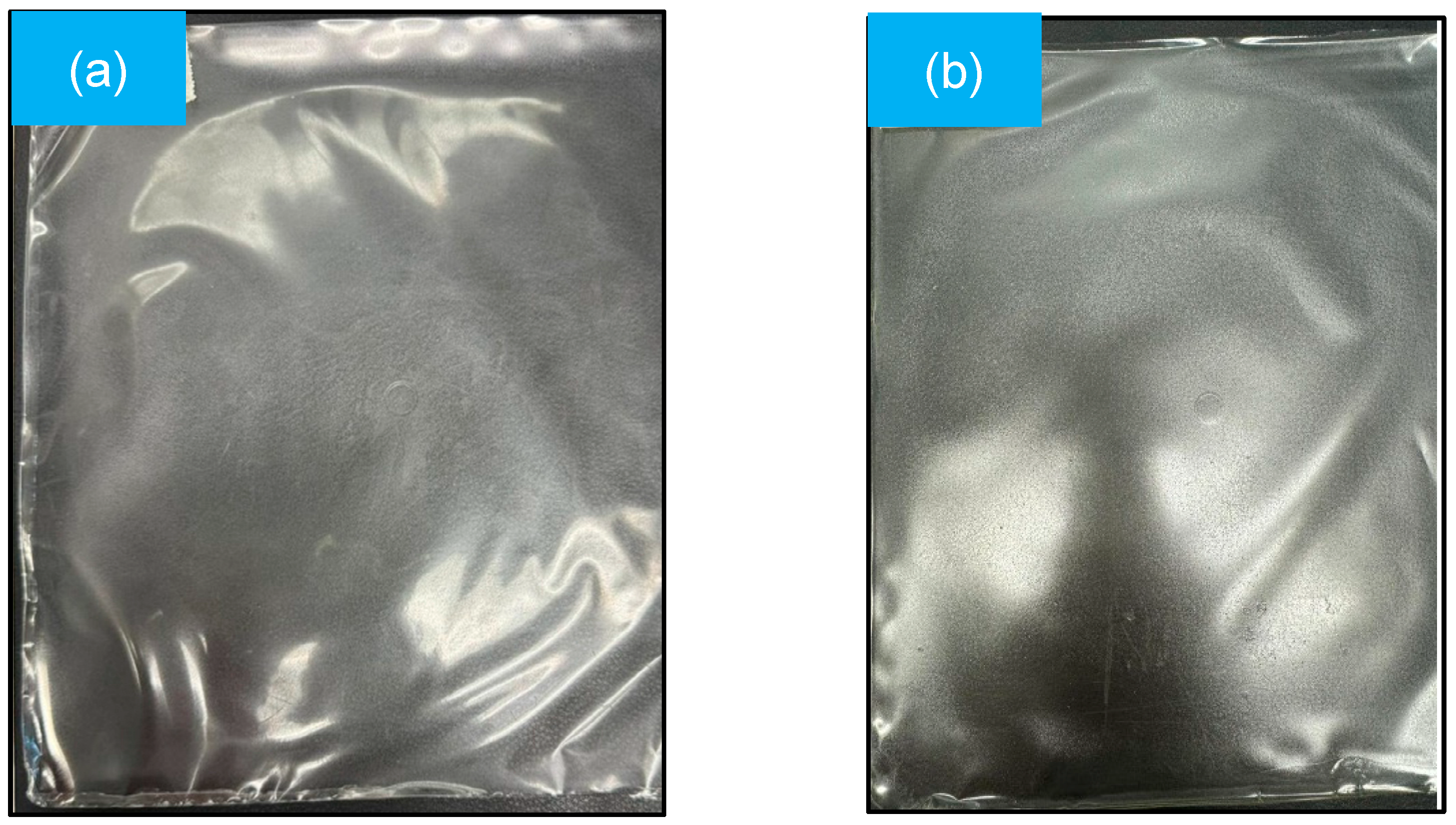

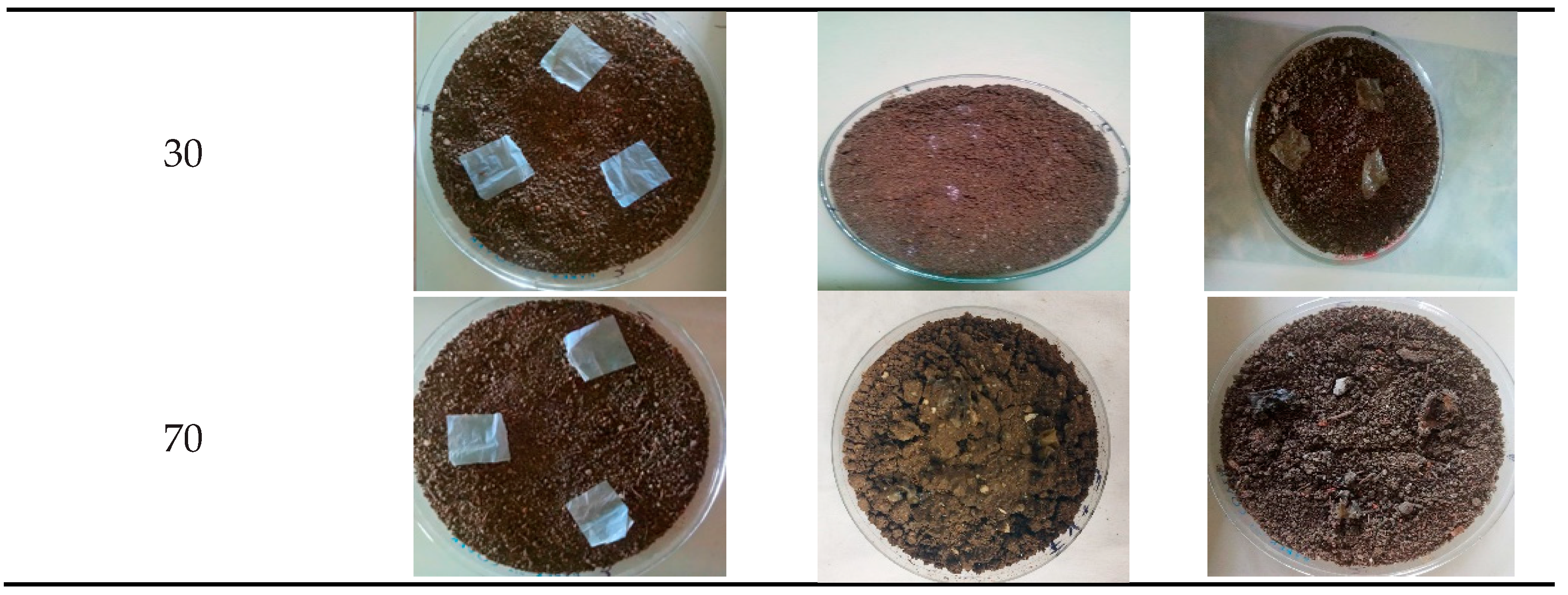
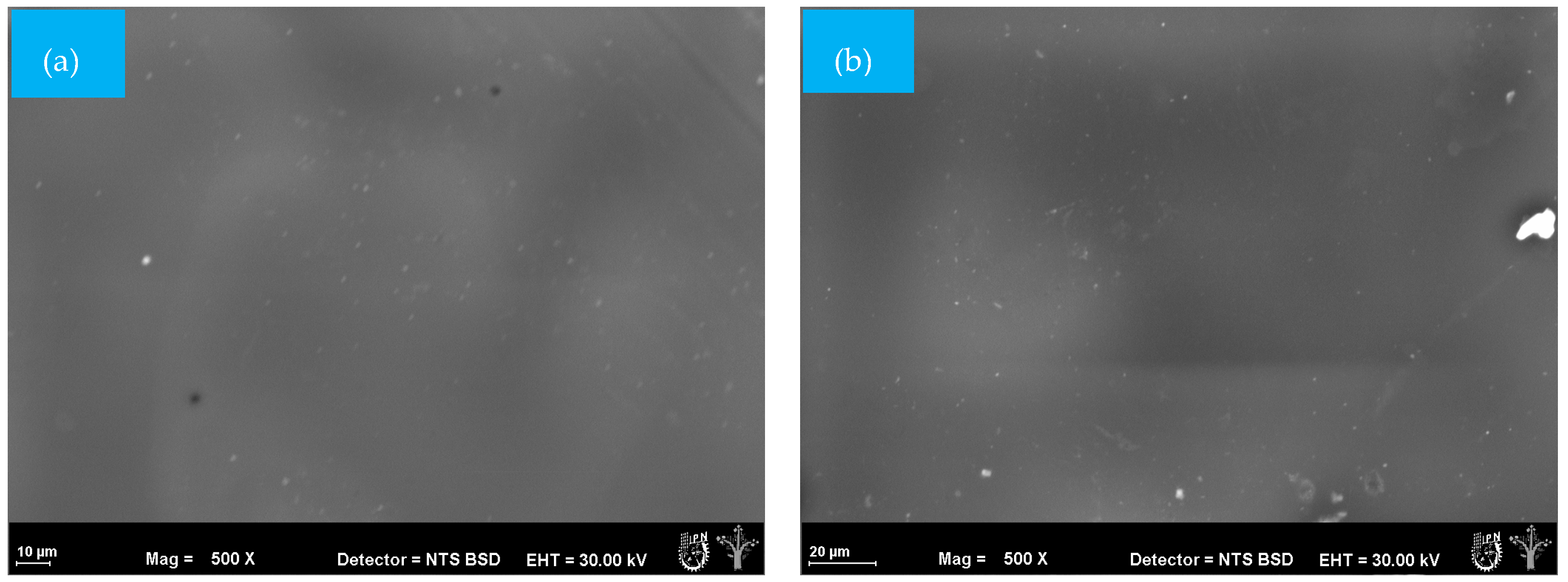
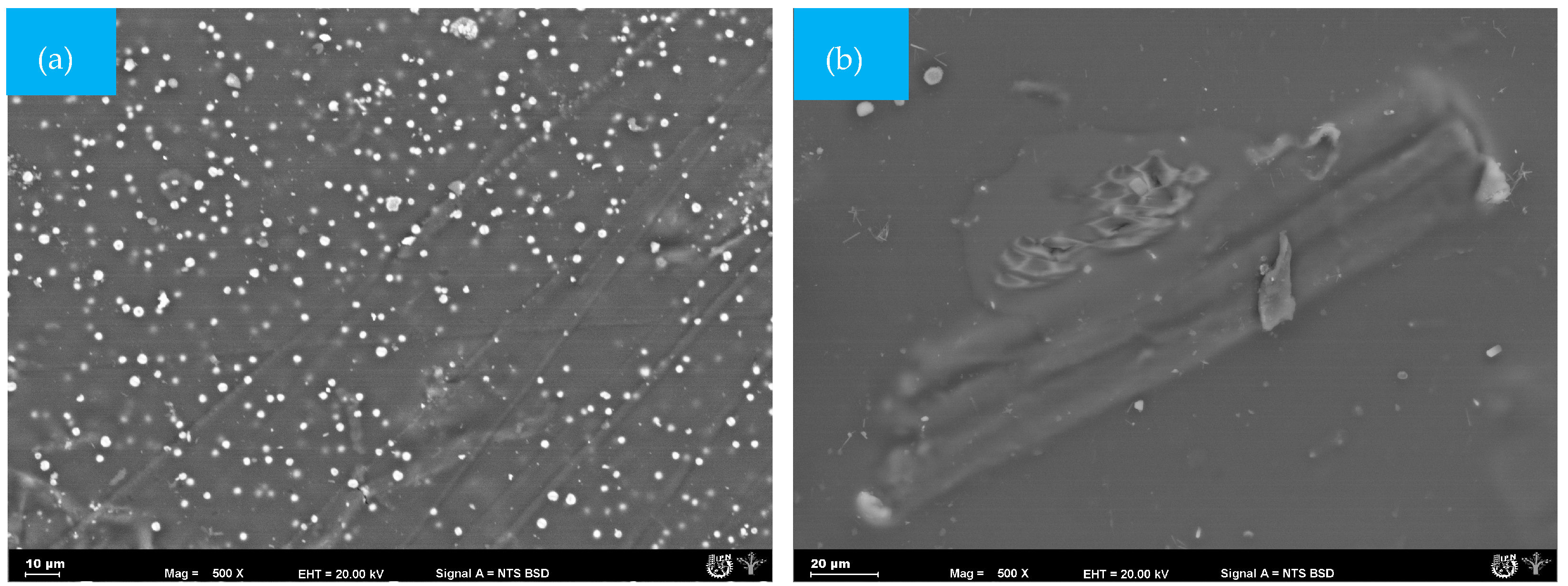
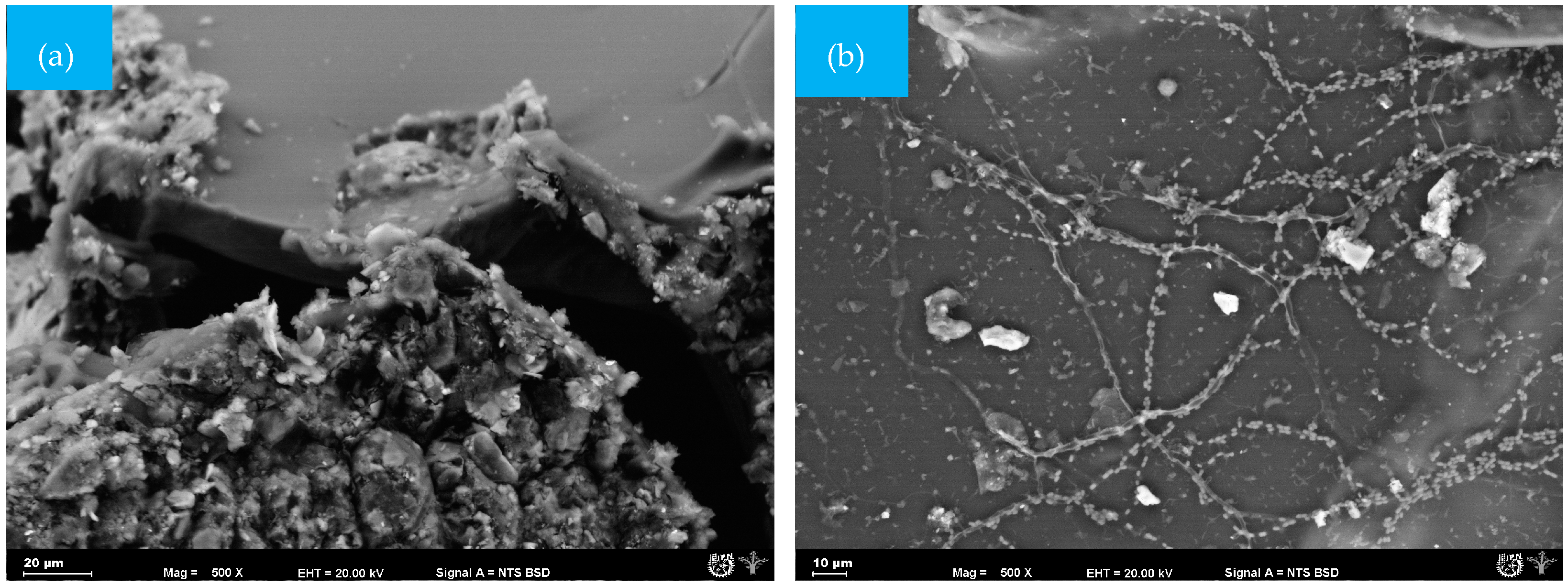
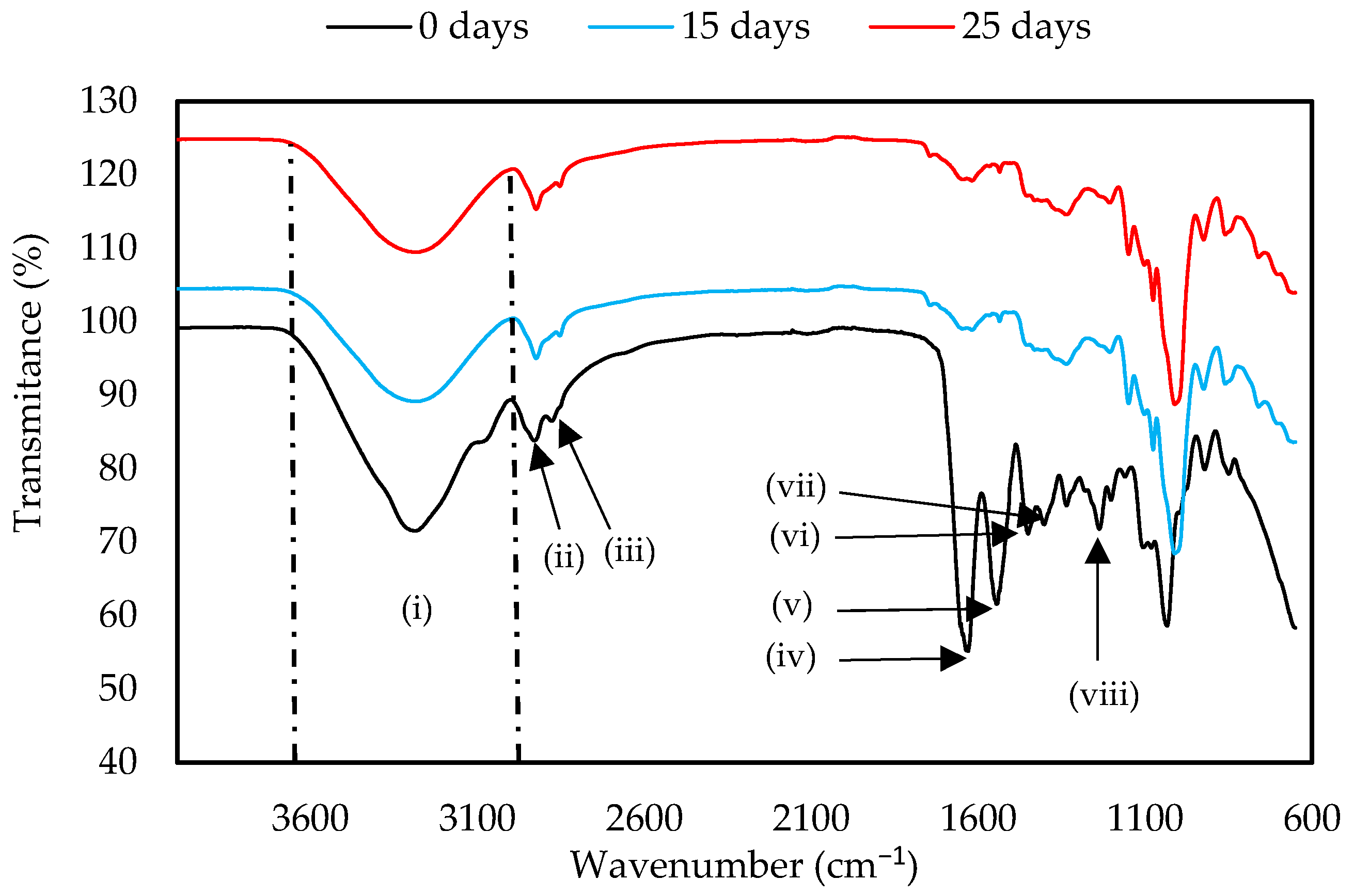
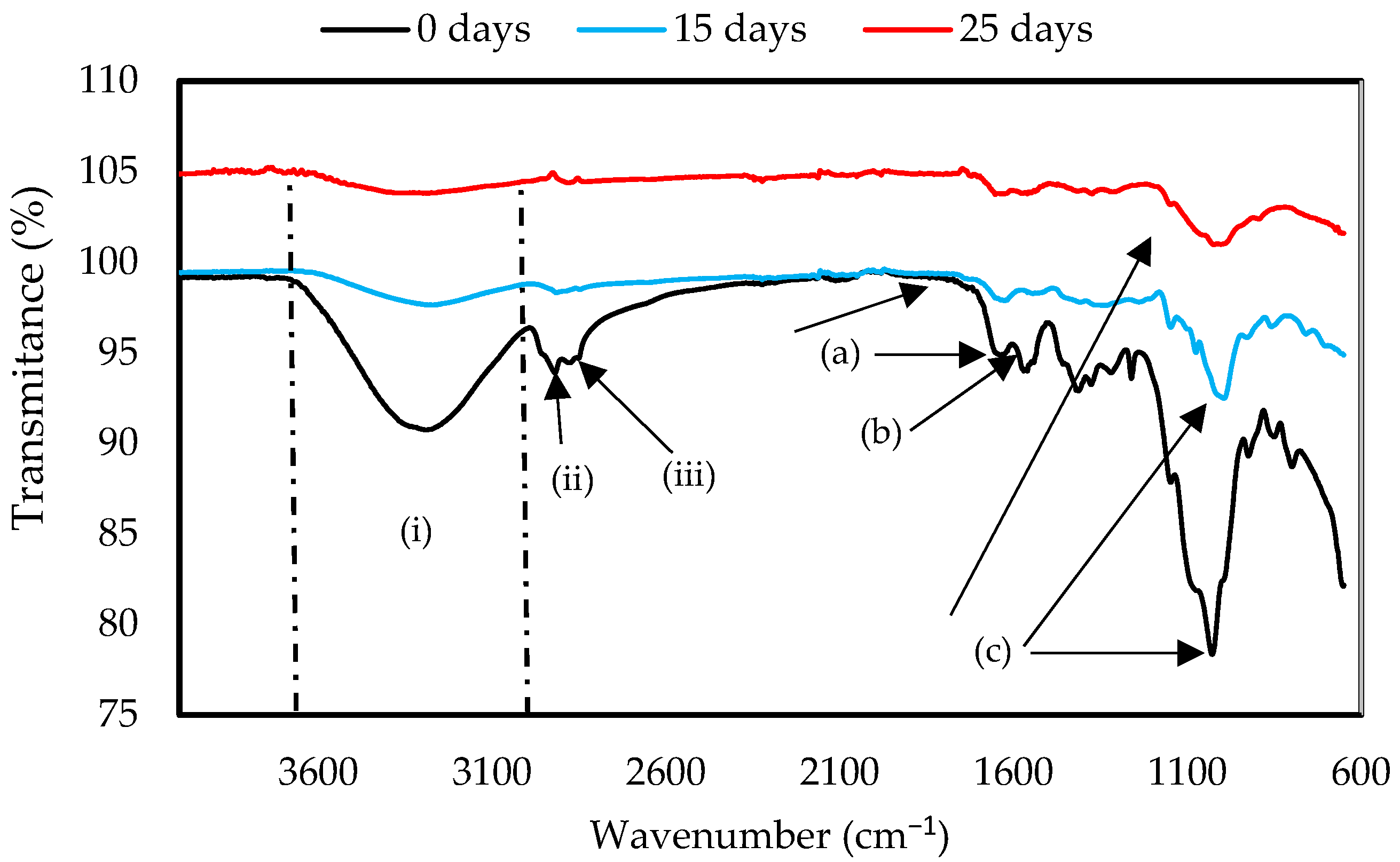
| Sample | pH | % Moisture | % Organic Material | % Carbon | % Nitrogen |
|---|---|---|---|---|---|
| soil | 8.2 | 6.33 | 5.59 | 9.63 | 0.18 |
| Cr | Ni | Cu | Zn | Pb | |
| 48 | 22 | 36 | 66 | 8 |
| Sample | Weigth Record (g) | |||||||
|---|---|---|---|---|---|---|---|---|
| Time (Days) | ||||||||
| 0 | 5 | 10 | 15 | 20 | 25 | 30 | 70 | |
| PM | 0.044 ± 0.002 | 0.044 ± 0.002 | 0.044 ± 0.002 | 0.044 ± 0.002 | 0.044 ± 0.002 | 0.044 ± 0.002 | 0.044 ± 0.002 | 0.044 ± 0.002 |
| GelC | 0.0359 ± 0.003 | 0.0326 ± 0.001 | 0.0251 ± 0.002 | 0.0161 ± 0.006 | 0.0114 ± 0.004 | 0.007 ± 0.001 | - | - |
| ChiC | 0.0225 ± 0.008 | 0.0216 ± 0.004 | 0.0184 ± 0.002 | 0.0135 ± 0.001 | 0.0101 ± 0.003 | 0.0094 ± 0.002 | 0.0078 ± 0.001 | 0.038 ± 0.003 |
| % weigth loss | ||||||||
| PM | 0 | 0 | 0 | 0 | 0 | 0 | 0 | |
| GelC | 9 | 30 | 55 | 68 | 80 | - | - | |
| ChiC | 4 | 18 | 40 | 55 | 58 | 65 | 97 | |
Disclaimer/Publisher’s Note: The statements, opinions and data contained in all publications are solely those of the individual author(s) and contributor(s) and not of MDPI and/or the editor(s). MDPI and/or the editor(s) disclaim responsibility for any injury to people or property resulting from any ideas, methods, instructions or products referred to in the content. |
© 2024 by the authors. Licensee MDPI, Basel, Switzerland. This article is an open access article distributed under the terms and conditions of the Creative Commons Attribution (CC BY) license (https://creativecommons.org/licenses/by/4.0/).
Share and Cite
Lorenzo Santiago, M.A.; Rendón Villalobos, J.R.; Contreras Ramos, S.M.; Pacheco Vargas, G.; García Hernández, E. Biodegradation Studies of Biobased Mulch Films Reinforced with Cellulose from Waste Mango. Recycling 2024, 9, 96. https://doi.org/10.3390/recycling9050096
Lorenzo Santiago MA, Rendón Villalobos JR, Contreras Ramos SM, Pacheco Vargas G, García Hernández E. Biodegradation Studies of Biobased Mulch Films Reinforced with Cellulose from Waste Mango. Recycling. 2024; 9(5):96. https://doi.org/10.3390/recycling9050096
Chicago/Turabian StyleLorenzo Santiago, Miguel Angel, J. Rodolfo Rendón Villalobos, Silvia Maribel Contreras Ramos, Glenda Pacheco Vargas, and Edgar García Hernández. 2024. "Biodegradation Studies of Biobased Mulch Films Reinforced with Cellulose from Waste Mango" Recycling 9, no. 5: 96. https://doi.org/10.3390/recycling9050096





